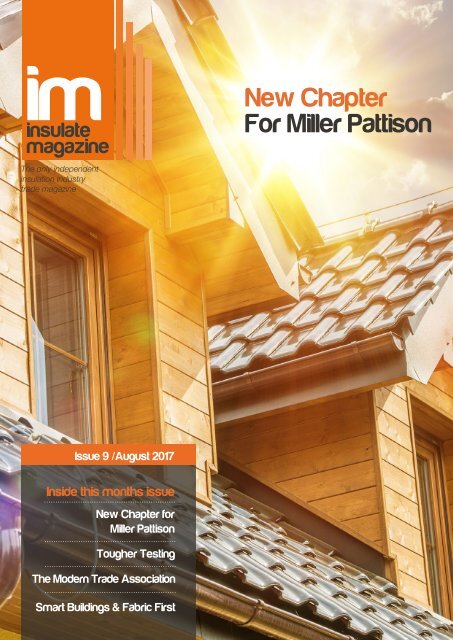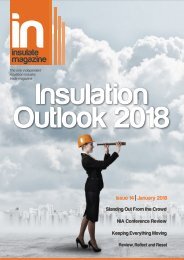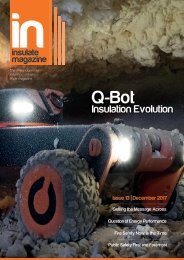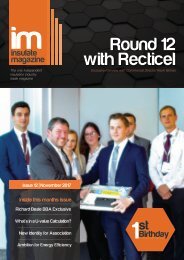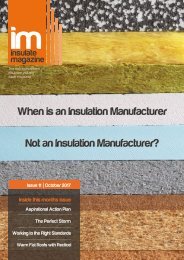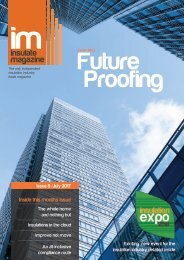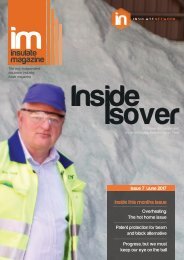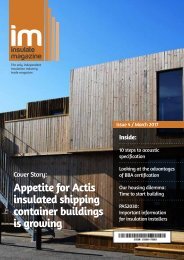Insulate Magazine Issue 9
You also want an ePaper? Increase the reach of your titles
YUMPU automatically turns print PDFs into web optimized ePapers that Google loves.
New Chapter<br />
For Miller Pattison<br />
The only independent<br />
insulation industry<br />
trade magazine<br />
<strong>Issue</strong> 9 /August 2017<br />
Inside this months issue<br />
New Chapter for<br />
Miller Pattison<br />
Tougher Testing<br />
The Modern Trade Association<br />
Smart Buildings & Fabric First
www.insulatenetwork.com<br />
Published on a monthly basis by Versanta ltd<br />
Corser House, 17 Geen End, Whitchurch, Shropshire, SY13 1AD<br />
Call 01948 759 351<br />
Outside of the UK +44 1948 759351<br />
Monday - Friday 9am - 5.30pm<br />
Website: www.insulatenetwork.com<br />
Email: sales@insulatenetwork.com<br />
SUBSCRIPTION INFORMATION<br />
Anyone can subscribe for free online at www.powerboatracingworld.com/subscribe<br />
or by phone on 01948 759 351.<br />
Subscriptions are available around the world free in digital format.<br />
Print subscriptions are available around the world, please call us for<br />
a quote or email us on sales@insulatenetwork.com<br />
Our subscriber list is occasionally made available to very carefully<br />
selected companies whose products or services may be of interest<br />
to you. Your privacy is of paramount importance to us and should<br />
you prefer not to be part of these lists then please email your details<br />
and a short message to sales@insulatenetwork.com<br />
CLASSIFIED ADVERTISING<br />
Rate: No photo classified £25 for 20 words, each additional word<br />
costs £1. All classified advertising must be paid in advance. We<br />
must receive your classified advert at least two weeks prior to the<br />
publication date.<br />
WE DO NOT ACCEPT PHONE IN CLASSIFIED ADVERTISING<br />
In the first instance, email your advert to sales@insulatenetwork.<br />
com and await your invoice, once payment is received our design<br />
team will clarify the advert insertion with you directly. CLASSIFIED<br />
ADVERTISING APPEARS IN PRINT AND ONLINE. WE ARE NOT<br />
RESPONSIBLE FOR ERRORS AFTER PROOFING AND INSER-<br />
TION.<br />
DISPLAY ADVERTISING.<br />
Contact one of our sales staff to discuss your requirements on<br />
01948 759 351. Publisher reserves the right to reject any<br />
advertising that in its opinion is misleading, unfair or incompatible<br />
with the character of the magazine.<br />
We adhere to the IPSO code of practice for editors. Further information<br />
can be found at www.ipso.org.uk<br />
BACK ISSUES OR REPRINTS<br />
Digital back issues can be foud online at www.insulatenetworkazine.com<br />
For printed editions please email contact@insulatenetwork.com<br />
, there will be a postage charge and handling fee of<br />
£5+VAT for each copy requested.<br />
CIRCULATION<br />
The magazine is sent to 17,000 digitial subscribers per month<br />
Contents<br />
A New Chapter for Miller Pattison<br />
The Modern Trade Association 10-12<br />
Engaging your Workforce 3M<br />
6-8<br />
16-18<br />
Tougher Testing BBA 20-21<br />
Government & Innovation - Actis 22-23<br />
Expertise - Darren Evans 24-25<br />
Rainscreen vs <strong>Insulate</strong>d - EPIC 30-31<br />
Smart Buildings & Fabric First 33-35<br />
Insulation Expo 2018 36-37<br />
Featured CPD's 39<br />
©VERSANTA LTD<br />
No part can be reproduced without the express<br />
permission of the publisher<br />
www.facebook.com/insulatenetwork<br />
www.twitter.com/insulatenetwork<br />
www.youtube.com/channel/insulatenetwork<br />
The UK's only dedicated<br />
trade journal for the insulation industry<br />
3
It’s been another turbulent month for the insulation industry<br />
in the wake of the Grenfell tower tragedy, with the results of<br />
the BS 8414 testing starting to be released just as we go<br />
to press. So far, all samples of ACM cladding that have been<br />
tested have reaffirmed the failure of the earlier tested samples,<br />
the government has issued advice to the owners of the 111<br />
buildings known to have this type of ACM cladding to ensure<br />
the safety of residents.<br />
Colin Heath<br />
Managing Editor<br />
Team<br />
Jamie Street<br />
Creative<br />
The government has also announced an independent review of<br />
building regulations and fire safety, something that I remember<br />
from four years ago in the wake of the Lakanal house fire, it is<br />
clearly long overdue. Chemical engineer Judith Hackitt will lead<br />
the review and will of course consult with the industry, fire safety<br />
experts and the Building Regulations Advisory Committee.<br />
<strong>Issue</strong> nine of <strong>Insulate</strong> magazine is here, great articles from our<br />
friends at Darren Evans Assessments Ltd and the BBA feature<br />
among my favourites this month! There is under a month for<br />
you to enter the highly sought after National Insulation Awards,<br />
don’t miss out!<br />
Enjoy<br />
4<br />
www.insulatenetwork.com
The only independent insulation industry trade magazine<br />
Cover Story<br />
New Chapter<br />
For Miller Pattison<br />
Managing Editor of <strong>Insulate</strong> <strong>Magazine</strong> Colin Heath Speaks to newly appointed Managing Director Alex Mcleod<br />
Alex, congratulations on the new role, could you describe<br />
Miller Pattison as a company for us?<br />
Miller Pattison is the UK’s leading specialist insulation<br />
service provider. Our 10 branches provide<br />
national coverage to our customers across the<br />
country. The company has built a tremendous<br />
reputation for quality and service which I will be<br />
building on in coming months.<br />
Under my predecessor, Mike Dyson’s, leadership,<br />
the team have achieved a huge<br />
transformation. The company has moved<br />
from being heavily involved with Government<br />
schemes, such as ECO and Green Deal, to<br />
having a much stronger focus on the new build<br />
market. We’re working predominantly in housing<br />
and more recently have been growing in a wide<br />
range of commercial contractor markets.<br />
Quite a transformation in in terms of organisational<br />
operations then?<br />
The staff and the whole organisation deserve<br />
a huge amount of credit for the transformation<br />
they’ve made to the business over the last couple<br />
of years. It’s changed dramatically in a short<br />
space of time and we’re now much more efficient.<br />
“Leaner” may be the best way of putting it.<br />
After a spell away from insulation,<br />
what drew you back?<br />
What attracted me to Miller Pattison is that the<br />
business has a great history, having been around<br />
for more than 50 years and a very strong brand<br />
that really speaks for itself.<br />
Miller Pattison has a 150 strong workforce and<br />
a very experienced management team. It’s a national<br />
business, which is important for creating a<br />
service platform, and its principal investor, Northedge<br />
Capital, is very supportive.<br />
Mike Dyson, my predecessor, has done a phenomenal<br />
job. He’s built a real platform for growth<br />
and there is a great scope to develop this company.<br />
We’re now very well placed to capitalise<br />
on growing construction markets, which I’m also<br />
really excited about.<br />
6<br />
www.insulatenetwork.com
So, there is still work to do in both regulatory and<br />
policy areas?<br />
New build markets have certainly been influenced by<br />
regulation and its standards have increased quite significantly,<br />
which I guess is your point. Not just thermal<br />
but also acoustic requirements have changed, which<br />
not only benefits the industry, but the homeowners,<br />
who have better homes to live in.<br />
Going back to the Government - if there is one challenge<br />
to think about, it is that through the schemes<br />
like subsidised insulation, I think the value of the<br />
product has reduced in consumers’ eyes - so it’s either<br />
“I’ll only do it if there is a grant attached” or “I’ll<br />
only do it if it’s free”. The Government schemes have<br />
been so important to the industry for such a long period<br />
of time. The challenge now for the sector to face<br />
is in recreating that value in consumers’ minds for<br />
products and solutions that do so much to improve<br />
the quality and comfort of their homes.<br />
How do you see us evolving<br />
in the next ten years?<br />
One thing we can absolutely guarantee is that when<br />
we try and predict what happens, it won’t happen as<br />
fast as we think.<br />
I think there’ll be issues with accessing qualified<br />
workforce and dealing with a lack of skills in construction<br />
will be a challenge and is already something<br />
that needs to be thought about. But technological<br />
developments may address some of these issues.<br />
No doubt the range of insulation materials will increase<br />
still further and we are watching with interest<br />
developments in off-site manufacturing, which UK<br />
Government is supportive of to address the housing<br />
shortage.<br />
7
The only independent insulation industry trade magazine<br />
At Miller Pattison, we will be investing in our people<br />
to help them support customers’ choices, which<br />
may well result in a widening of the products and<br />
services we offer in future.<br />
So, what about Brexit and its impact?<br />
As we are currently heavily focused on the housing<br />
market, irrespective of Brexit, it is being supported<br />
by the Government through Help to Buy<br />
and a range of other schemes and policies, which<br />
is good for Miller Pattison. However, demand<br />
for housing is clearly going to be linked to how<br />
people think of the economy, so I believe the jury<br />
is still out on what impact Brexit will have on the<br />
economy and therefore the sentiment about making<br />
large purchases.<br />
There certainly is a lot of volatility in views about<br />
what will happen over the next few years and the<br />
impact of Brexit on the economy is something<br />
that experts seem to be struggling to evaluate at<br />
this stage as well.<br />
I do wonder what impact Brexit will have on future<br />
investment in the industry if you throw in the fact<br />
that so much of the insulation manufacturing industry<br />
is in foreign ownership. Hopefully we won’t<br />
see a prolonged period of uncertainty, which might<br />
influence decisions made in boardrooms across<br />
Europe and beyond.<br />
The other thing that has an immediate impact is the<br />
exchange rate, which has collapsed post-Brexit<br />
and is bound to influence imported materials. This<br />
will inevitably influence builders’ choices as different<br />
products are impacted in different ways by the<br />
exchange rate.<br />
And Miller Pattison in the future?<br />
Immediate plans for Miller Pattison are to carry<br />
on the good work Mike Dyson started. There is<br />
a platform for growth, and I’m hugely impressed<br />
with what he and the management team have<br />
done so far. The focus for us is quality, service,<br />
and efficiency and we’ve made huge strides on<br />
these already.<br />
Our paperless approach has enabled us to become<br />
more efficient in the last year and I would<br />
expect our service to be one of the best in the<br />
industry. We are currently undertaking a customer<br />
service survey and the initial results have been<br />
very positive. It’s exciting to be able to gather the<br />
data about the quality of our work and then relay<br />
it back to our customers, which we will be doing<br />
shortly.<br />
As for our future - you’ll have to watch this space!<br />
There are a lot of opportunities for the business<br />
and we have no shortage of ideas, which is another<br />
reason why I am so genuinely excited to join<br />
Miller Pattison. So, please, come back and see us<br />
again to see how we progress and what our next<br />
steps are going to be.<br />
Immediate plans for Miller Pattison<br />
are to carry on the good work Mike<br />
Dyson started. There is a<br />
platform for growth and I am<br />
hugely impressed with what he<br />
and the management team have<br />
done so far.<br />
8<br />
www.insulatenetwork.com
The UK's Only Exhibition<br />
Dedicated to the Insulation Industry<br />
Showcasing the latest insulation innovations, perspectives & expertise<br />
18th & 19th June 2018 | EMCC Nottingham<br />
Register for your free visitor ticket<br />
Book your exhibitor space<br />
www.insulationexpo.co.uk<br />
@insulationexpo
The only independent insulation industry trade magazine<br />
<strong>Insulate</strong> debate<br />
The Modern Trade Association:<br />
No old boys clubs here please<br />
Written by <strong>Insulate</strong> Network’s Managing Editor Colin Heath<br />
If you’re a small business owner or a director of a major multinational, you could<br />
be forgiven for not wanting to add another event to your calendar, so what would<br />
the benefits of adding a time-consuming trade organisation to your working<br />
week. In this series of articles, we hope to uncover the reason for Trade Associations,<br />
who their members are, who runs them and the benefits (if any) of what they do.<br />
Part One<br />
Membership in an Industry Association offers<br />
numerous benefits (according to the various<br />
Industry Associations we spoke to), their offering<br />
will keep you abreast of important, ever-changing<br />
issues, trends and legislation within the marketplace.<br />
You are provided with a shiny logo to use<br />
on your businesses website to promote your<br />
membership to prospective customers, there are<br />
events to attend for networking along with an<br />
Annual Conference and AGM.<br />
Most of the larger insulation multinationals are<br />
members of multiple trade bodies dependant on<br />
their different product ranges.<br />
TICA<br />
Benefits of membership vary by organisation, for<br />
example, as a member of TICA<br />
(Thermal Insulation Contractors Association),<br />
contractors have access to all-inclusive member<br />
resources and tools through their website, as<br />
well as full access to dispensations through the<br />
Thermal Insulation Contracting Industry (TICI)<br />
Collective Working Agreement. TICA members<br />
benefit from a wide variety of support ranging<br />
from access to a top 500 HR Consultant through<br />
to recruitment and training of apprentices.<br />
TICA has been at the forefront of the<br />
Governments Apprenticeship Trailblazer process.<br />
This involved in- depth consultation with their<br />
members in order to focus on what skills the<br />
employers really needed in today’s modern<br />
market, and not therefore just producing<br />
insulation skills in an operative that are expensive<br />
and in many cases unnecessary for the modern-day<br />
contractor. modern Trade Association<br />
works at its best in partnership with its members<br />
to modernise the<br />
10 www.insulatenetwork.com
sector in a way that neither party could<br />
achieve on their own. The result is a two-tiered<br />
approach to thermal insulation, accepting that<br />
not all employers will need fabrication skills<br />
in all of their operatives. The new Standards<br />
will offer a choice between a Level 2 Thermal<br />
Operative who is skilled to fit insulation and<br />
pre-fabricated cladding, and a Level 3 Advanced<br />
Craft Technician, who is skilled in pattern<br />
development and metal fabrication. These<br />
developments need the input of members<br />
to facilitate the Trade Associations work to<br />
achieve the correct end result to take forward<br />
the sector skills for the future. It shows how a<br />
modern Trade Association works at its best -<br />
in partnership with its members to modernise<br />
the sector in a way that neither party could<br />
achieve on their own.<br />
BRUFMA<br />
Whereas the British Rigid Urethane Manufacturers<br />
Association (BRUFMA) provides a<br />
platform for it’s members to inform, engage<br />
and influence key stakeholders about all issues<br />
relating to PIR/PUR insulation in the UK and<br />
Ireland.<br />
By acting as a single voice for the industry<br />
BRUFMA has created a positive and dynamic<br />
business environment in which to promote the<br />
benefits of PIR/PUR, including the development<br />
of appropriate product and application<br />
standards.<br />
BRUFMA has achieved enormous credibility<br />
with many Government and non-Governmental<br />
organisations who are involved in the<br />
legislative areas affecting the production and<br />
use of PIR/PUR insulation products and it can<br />
provide independent and balanced information<br />
insulatenetwork 11
www.insulatenetwork.com<br />
and education on the industry and its products.<br />
It also works to develop the industry and its markets<br />
through collaborative research and<br />
educational projects spanning stakeholders<br />
across Europe.<br />
Speaking on membership BRUFMA CEO,<br />
Simon Storer told us;<br />
“We now have within our membership all the<br />
manufacturers of PIR/PUR in the UK and Ireland<br />
as well as suppliers of the various raw materials<br />
and associated services. This means that<br />
BRUFMA really can speak for the industry on all<br />
issues, including technical developments and<br />
policy direction”<br />
“Our aim is to continue to increase our access<br />
and influence to a range of target audiences, so<br />
they have better knowledge about the benefits of<br />
the products and have an informed view, which<br />
has not always been the case in the past. We<br />
are also the main point of contact for information<br />
about the sector”<br />
“Importantly, BRUFMA acts as a conduit of information<br />
both for and on behalf of the industry; a<br />
collective view outward to stakeholders from the<br />
industry; and a source of information inwards that<br />
we can disseminate across our membership. In<br />
this way, we are sure to keep the industry up to<br />
speed with key developments and ensure we<br />
have a seat at the table and can participate in all<br />
issue that are of key importance and relevance”<br />
apply such as one-time application fees. Some<br />
Associations offer reduced rates for student<br />
members, for example. Furthermore, some<br />
Associations demand that you meet preliminary<br />
requirements to become a member.<br />
The inner workings of each organisation within<br />
the Insulation sector are reserved for members<br />
and delegates of the AGM however <strong>Insulate</strong><br />
<strong>Magazine</strong> has learned that some associations will<br />
also charge you further for the privilege of attending<br />
this event.<br />
Membership in Trade Associations not only<br />
benefits you and the employees of your company,<br />
but it also projects a positive image of<br />
your company to your customers. Membership<br />
in Associations shows a business’ initiative, its<br />
engagement in a particular policy or regulation<br />
and its commitment to staying abreast of current<br />
developments in the marketplace.<br />
Coming in Part 2<br />
Next month we will talk to members of<br />
these organisations, get their thoughts on<br />
the work that is undertaken to promote<br />
the insulation industry and their individual<br />
companies, by these elected and employed<br />
“voices” of the industry.<br />
Join the “<strong>Insulate</strong> Debate” on this<br />
or any other article at<br />
www.insulatenetwork.com<br />
Memberships<br />
Annual fees for membership also vary, the memberships<br />
numbers of each organisation clearly<br />
show that the benefits outweigh the costs, rates<br />
may vary depending on what type of<br />
membership you’re interested in. Other fees may<br />
With thanks to:<br />
KNOWLEDGE IN INSULATION<br />
12<br />
insulatenetwork
SIG360 work with us<br />
on site, to ensure we<br />
not only meet our<br />
client’s needs but<br />
exceed them.<br />
NEIL HARRISON<br />
HARRISON PROJECTS<br />
AN SIG CUSTOMER<br />
BUILD YOUR NAME ON US<br />
Providing impartial<br />
product advice<br />
The SIG360 Technical Centre is a service offering from SIG, that focuses on helping customers<br />
deliver energy efficient buildings.<br />
Through an intimate knowledge of building regulations and product performance, brought<br />
about through more than 50 years specialising in the energy efficiency of the fabric of a<br />
building, the SIG360 Technical Centre is able to make cost effective and impartial product<br />
selection to ensure the best energy performance can be achieved.<br />
The service provided includes energy statements, U value calculations , condensation risk<br />
analysis, thermal modelling and SAP assessments leading to EPC certification.<br />
If you are seeking impartial advice on the fabric energy efficiency of your building contact<br />
SIG360 Technical Centre.<br />
For guidance you can trust call 0844 443 0059<br />
email 360enquiries@sigplc.com or visit www.sig360.co.uk<br />
Talk to the SIG360 Technical<br />
Centre at the start of your project<br />
for a 360 o view of cost effective<br />
and energy efficient home building
Thursday 30 th November 2017<br />
East Midlands Conference Centre & Orchard Hotel<br />
Expert judge panel<br />
22 awards categories<br />
BREEAM Excellent rated venue<br />
Unmissable night of celebration<br />
5 course meal, wine and champagne<br />
Evening hosted by TV personality Nick Knowles<br />
Accepting FREE entries now<br />
www.insulationawards.co.uk | info@insulationawards.co.uk | 01948 759 351
Will you be a winner?<br />
Entry Deadline Approaches!<br />
Award sponsorship & VIP opportunities available<br />
NiiAwards
The only independent insulation industry trade magazine<br />
Health & Safety<br />
Engaging your workforce<br />
for a safe environment<br />
<strong>Insulate</strong> <strong>Magazine</strong> columnist George Elliott, a technical specialist at science-based technology 3M,<br />
explains the need for engaging with employees about health and safety issues, and offers advice about how to do this<br />
Health and safety could hardly be a more important topic for those working in the insulation<br />
industry, as it affects their very wellbeing. Yet engaging workers on this subject<br />
can sometimes be difficult. Some may perceive safety requirements to be a chore or an<br />
obstacle to their work, while others may have fooled themselves into believing that accidents<br />
only ever happen to others. Nevertheless, employers have a duty to ensure that employees<br />
understand the risks in their workplace, and the procedures they must comply with in order<br />
to protect themselves and their colleagues. As a company dedicated to increasing workplace<br />
safety, 3M is always keen to offer advice to help with this.<br />
Workers' Choice<br />
One way of engaging workers is to involve them<br />
in the Personal Protective Equipment (PPE)<br />
selection process – something 3M promotes<br />
through its Workers’ Choice campaign.<br />
Not only do workers appreciate being listened<br />
to, but their feedback can be a great help to<br />
employers and health and safety managers when<br />
trying to choose from a wide range of equipment<br />
options.<br />
Those who will be wearing the PPE day-to-day<br />
will be best able to assess a particular product’s<br />
comfort level, as well as its other pros and cons.<br />
Such considerations are paramount, because all<br />
PPE must be suitable for the individual wearer<br />
and the environment, as well as being adequate<br />
to protect against the hazard, or hazards, in your<br />
workplace.<br />
When PPE is suitable, employees are more likely<br />
to accept it. When it isn’t – when workers find it<br />
uncomfortable, for example – they are more likely<br />
to wear it incorrectly or remove it entirely.<br />
For example, individuals may place their<br />
safety eyewear on their heads if they find it too<br />
tight, or unzip their coveralls if the material is not<br />
breathable enough, leaving them potentially<br />
exposed to hazards<br />
16<br />
www.insulatenetwork.com
Communicating your messages<br />
When it comes to communicating your<br />
messages, it is important to recognise that<br />
there are three main learning styles – visual,<br />
audio and kinaesthetic.<br />
Visual learners respond best to information<br />
they can see, such as images, charts, videos<br />
and demonstrations. YouTube can be a rich resource<br />
for health and safety information. However,<br />
employers should ensure that the source<br />
is reputable and the material complies with regulations<br />
in their geographical location.<br />
Audio learners most easily absorb<br />
information they hear, whether from live<br />
talks, online webinars, podcasts or video<br />
soundtracks. Copyright-free material can often<br />
be found online. Again, employers should satisfy<br />
themselves that any material given to employees is<br />
appropriate. Kinaesthetic learners prefer to<br />
learn by doing. This can involve hands-on<br />
practical demonstrations.<br />
For most people, the most effective approach<br />
is to present information using a mixture of<br />
these methods. Whichever approach you take,<br />
always remember to focus on one key issue at<br />
a time, as too much information at once can<br />
confuse the audience. Also, don’t be afraid to<br />
repeat your message. The more employees<br />
hear it, the more likely they are to retain it.<br />
When PPE is suitable,<br />
employees are more likely to<br />
accept it. When it isn’t – when<br />
workers find it uncomfortable, for<br />
example – they are more likely to<br />
wear it incorrectly or remove it<br />
entirely.<br />
17
The only independent insulation industry trade magazine<br />
Training<br />
Regular training is also a crucial part of any effective<br />
communications strategy, as it helps to keep<br />
health and safety at the front of employees’ minds.<br />
Whether working with a new recruit for the first<br />
time or going over old ground with a long-standing<br />
member of the team, training will reinforce the<br />
importance of what they are doing.<br />
Training should cover the hazards present, the<br />
control measures required and how to implement<br />
them, including when, where, why and how to<br />
wear PPE.<br />
Discussion and debate about health and safety<br />
topics should also be encouraged in the workplace<br />
generally, not just in training sessions. This<br />
is something 3M’s SafeTea Break campaign aims<br />
to help with.<br />
Health and safety managers can request a Safe-<br />
Tea Break toolkit from 3M, with the prepared toolbox<br />
talks, designed to spark debate at work by<br />
filling out a form on the company’s website. This<br />
can ultimately help employers to create a useful<br />
health and safety action plan, while also fostering<br />
an inclusive safety culture in the workplace.<br />
By using these tips, employers and health and safety managers will<br />
be able to engage better with workers about health and safety issues,<br />
helping to create a safer work environment.<br />
For more information on any of these topics, or for general information<br />
about health and safety in the workplace, call the 3M helpline on 0870<br />
608 0060. For more information about 3M, visit www.3M.co.uk/safety<br />
18
WIN!!<br />
<strong>Insulate</strong> Network have<br />
a fantastic Goody Bag<br />
from 3M to giveaway.<br />
For the chance to win visit<br />
www.insulatenetwork.com/3Mcomp<br />
and subscribe to <strong>Insulate</strong> Network.*<br />
3M PPE Goody Bag Includes<br />
1 2<br />
3 4<br />
5<br />
*It is the wearer’s own responsibility to ensure that they are using<br />
the correct PPE for whatever application they are using it for.<br />
Worth £200!<br />
www.insulatenetwork.com/3Mcomp
The only independent insulation industry trade magazine<br />
Knowledge<br />
The bigger the noise your<br />
innovation makes in the industry<br />
the tougher the testing needs to be<br />
The BBA gives firm advice on why the testing of building products<br />
can never be a case of hit or miss.<br />
The record charts used to be called the BBC<br />
hit parade. And a hit was a successful tune<br />
or song. There was even a quiz panel TV<br />
programme called ‘Juke Box Jury’ where celebrities<br />
predicted new songs to be hits or misses.<br />
Since those days, a number of other charts have<br />
cropped up in other areas; top ten TV personalities<br />
of the year, top five films, top five holiday destinations<br />
etc.<br />
Introducing the BBAs<br />
Top 5 Reasons Why Products Fail<br />
Far from being a concept born of idle curiosity, it is<br />
intended to be helpful and informative to manufacturers<br />
wishing to avoid common pitfalls when commissioning<br />
often costly testing and assessment<br />
procedures to obtain BBA Agrément Certificates.<br />
In the world of building and construction, it is<br />
unlikely that anyone has come up with popularity<br />
charts for products and systems. It might be a fun<br />
exercise for people operating within the industry,<br />
but most of us are too busy to be speculating in<br />
areas of pure interest. It could be said that it simply<br />
wouldn’t be particularly productive to get side<br />
tracked with popularity charts for the purposes of<br />
amusement.<br />
However, there is an exception to that notion. The<br />
BBA have introduced a top five chart with a difference.<br />
Our Test Services team have put together<br />
the following:<br />
So for your entertainment,<br />
as well as the benefit of<br />
innovators everywhere,<br />
here are the top five in the<br />
current BBA Miss Parade ><br />
20<br />
www.insulatenetwork.com
www.insulatenetwork.com<br />
Straight in at N O 1 : Incorrect installation<br />
If a product is being built or assembled onsite<br />
for testing, we are required to observe this without<br />
interference. If the installation is performed<br />
incorrectly and not to standard, we clearly<br />
cannot perform the necessary assessments.<br />
Similarly, some products are delivered incorrectly<br />
assembled. For example, where we are<br />
assessing an exposed surface condition, that<br />
surface needs to be free from extraneous materials.<br />
Some items have been tampered with to<br />
such an extent that external substances cannot<br />
be removed without damage to the product<br />
surface.<br />
N O 2: Inadequate Product Spec<br />
Sometimes the product does not meet the<br />
specification requirements of the standard.<br />
For example, samples submitted for thermal<br />
conductivity tests are required to be smooth<br />
and flat with parallel surfaces to enable good<br />
contact between the specimen and the plates<br />
of the Heat Flow Meter. They also need to be of<br />
certain dimensions to allow testing using specially<br />
designed equipment.<br />
N O 3 and rising: Poor packaging<br />
exposed to moisture and/or damaged beyond<br />
use, often with missing or illegible labelling making<br />
it difficult or impossible to identify different<br />
batches/lots.<br />
N O 4: Cavity Wall Insulation (CWI)<br />
Wet Wall Test failures<br />
The definitive evidence of failure is moisture<br />
crossing the cavity, manifesting as damp areas<br />
on the block walls. Likely reasons for this will<br />
vary according to the type of material used.<br />
These can include inadequate fills, inadequate<br />
product properties, poor installation or unsuitable<br />
equipment, inappropriate cavity width for<br />
certain product types. All these can contribute<br />
to failure, allowing water/damp to travel across<br />
to the inner wall.<br />
Last but definitely not least N O 5:<br />
External Wall Insulation (EWI)<br />
dynamic wind loading test failures<br />
With ETICs systems, wind loading failures are<br />
due to pull through of fixings (either through the<br />
insulation or sheathing) or pull out of fixing from<br />
masonry or sheathing, or delamination of render<br />
from insulation. Note: The absolute number<br />
one cause of these failures is poor installation.<br />
Occasionally samples are not packaged adequately<br />
to protect them in transit; they become<br />
In the Building and Construction industry, if a new product is issued<br />
with a BBA Certificate, and subsequently becomes a hit in the<br />
market place, it will have nothing to do with hype or chance, just<br />
pure innovation genius combined with first class testing expertise.<br />
Some manufacturers whose products come close but fail at the end<br />
of the day may come away with a feeling that life has treated them<br />
unfairly. But then is life fair?<br />
The jury’s still out on that one<br />
insulatenetwork 21
The only independent insulation industry trade magazine<br />
Case Study<br />
Governments new energy plan<br />
needs to work alongside<br />
innovations in construction<br />
Plans announced this week by the<br />
government and Ofgem to invest in<br />
smarter, more flexible methods of<br />
generating and using energy need to work<br />
alongside innovative ways of ensuring homes<br />
are as energy efficient as possible, says<br />
insulation specialist Actis.<br />
The comments follow the launch on Monday of the<br />
Upgrading our Energy Systems - Smart Systems<br />
and Flexibility Plan by business secretary Greg<br />
Clarke, who says its implementation will help consumers<br />
save up to £40bn by 2050.<br />
Actis UK and Ireland commercial director Mark<br />
Cooper welcomed the innovative approach to energy<br />
generation and usage. He said this ‘outside<br />
the box’ thinking echoed sentiments in the recent<br />
Farmer Review of the Construction Labour Model<br />
which challenged the building industry to radically<br />
rethink how it operates in order to survive.<br />
“Innovation in energy generation and use has to<br />
go hand in hand with innovative new ways of creating<br />
the homes in which consumers will use this<br />
energy,” he explained<br />
Commissioned by the Department for Communities<br />
and Local Government and Department for<br />
Business, Energy and Industrial Strategy,<br />
22 22<br />
www.insulatenetwork.com
www.insulatenetwork.com<br />
the report’s author Mark Farmer said<br />
construction should be more like a car factory<br />
production line, with every section deliverable to<br />
a pre-determined quality standard.<br />
Mark Cooper continued:<br />
“We at Actis have been at the forefront of new<br />
technologies for a number of years with our innovative<br />
insulation products. The industry as a whole<br />
needs to take a broader approach to ensure energy<br />
efficiency standards continue to improve and to<br />
address immediate and medium term issues such<br />
as a shortage of skilled labour and a huge need for<br />
more housing.<br />
“We are among those pushing for more focus on<br />
offsite construction whose build speed, and the<br />
relative ease with which timber frame houses can<br />
be constructed, is vital at a time when the country<br />
is in dire need of additional housing and when the<br />
number of skilled workers is dwindling.<br />
“For maximum effectiveness, the government’s<br />
smart energy plan also needs to be combined with<br />
a concerted effort to ensure consumers are fully<br />
aware of the new options open to them. For example,<br />
they need to understand that not only will new<br />
technologies help them save money when using domestic<br />
appliances, but that when it comes to heating,<br />
the first line of defence against energy wastage<br />
is to ensure the physical envelope of their home<br />
is energy efficient. Better to have a home which<br />
retains the heat in the first place than one heated<br />
by renewables which leak out through the walls and<br />
roof as fast as you can say solar PV panel…”<br />
This combination of maximising fabric energy<br />
efficiency and minimising financial outgoings is<br />
illustrated by an Isle of Wight self builder whose<br />
primary aim was to protect his purse from the<br />
utility companies.<br />
Phil Clabburn insulated his 1900 sq ft<br />
traditionally styled timber frame home<br />
with Actis Hybris and insulating vapour<br />
control layer H Control Hybrid to ensure<br />
a thermally efficient shell, while installing<br />
a wood pellet burner, rainwater recovery<br />
system, solar thermal panel and LED<br />
lighting.<br />
Phil explained:<br />
“My objective was not to go all eco and<br />
save the planet and do a Kevin<br />
McCloud. It was simply to save ourselves<br />
from the utility companies! Looking at<br />
the project scientifically, I had some key<br />
objectives I wanted to achieve - mega insulation,<br />
low energy usage and low water<br />
consumption. This has been achieved by<br />
simple technologies, not complicated,<br />
expensive ones which consume lots of<br />
electricity!”<br />
Solihull-based Ardenvale Ltd chose to<br />
use products from the Actis Hybrid range<br />
when it converted a 10,000 sq ft 1940s<br />
one time hen house into a selection of one<br />
and two bedroom cottages.<br />
It chose insulating vapour control layer H<br />
Control Hybrid for the walls and 45mm<br />
honeycomb style insulation Hybris, H<br />
Control Hybrid and multifoil TS10+ for the<br />
roofs – for their combination of thermal<br />
efficiency and thinness. The properties<br />
also benefit from underfloor heating provided<br />
via an air source heat pump.<br />
insulatenetwork<br />
23
The only independent insulation industry trade magazine<br />
Case Study<br />
Expertise Plays a Part in<br />
Stunning Coastal Holiday Home<br />
When it came to the replacement of<br />
a landslide-damaged holiday home<br />
on Dorset’s Jurassic coast, future<br />
proofing was a key consideration with the<br />
new timber framed home designed in a way<br />
that ensured it would be protected against<br />
future landslides. As part of this long-term<br />
view, experts in energy efficiency, Darren<br />
Evans Assessments, provided guidance and<br />
advice to ensure this innovative project met<br />
its sustainability requirements and is as<br />
energy efficient as possible<br />
Designed by architects AR Design Studio and<br />
shortlisted for a RIBA award, the Crow’s Nest<br />
near Lyme Regis is a larch clad house which sits<br />
against a wooded backdrop and has uninterrupted<br />
views across the English Channel. It’s four linked<br />
timber frame pods – comprising the entrance,<br />
living space, two storey family tower, and single<br />
storey guest wing – are built on a floating structural<br />
frame which is laid on top of dwarf walls to act as<br />
an adjustable raft in case of future land movement.<br />
Designed to last for generations, energy efficiency<br />
is also at the heart of this inspired design with Darren<br />
Evans Assessments working with the architect<br />
in helping to create a more sustainable and energy<br />
efficient building.<br />
24
www.insulatenetwork.com<br />
To meet Building Regulations Part L, the SAP<br />
Calculations carried out by Darren Evans Assessments<br />
showed an improvement over emissions<br />
targets and a nearly 9.5% improvement on fabric<br />
energy efficiency targets.<br />
The team also looked at minimising thermal<br />
bridging by following Accredited Construction<br />
Details (ACDs) so that the architects could design<br />
out thermal bridges and improve thermal values<br />
at junctions.<br />
Central to the energy performance of the building<br />
was the creation of an efficient building envelope<br />
with high levels of insulation throughout. Other<br />
measures included a wood burner to reduce the<br />
energy demand on the mains gas heating,<br />
low energy lighting and the orientation of the<br />
home in terms of glazing maximises solar gains in<br />
winter whilst at the same time reduces overheating<br />
risk and the cooling demand in summer.<br />
Commenting on the work of Darren Assessments,<br />
Andrew Badley of AR Design said:<br />
“As expected Darren Evans Assessments were<br />
easy to work with and quickly resolved issues as<br />
they arose by tweaking our environmental and<br />
sustainable solutions. It’s why we use them on<br />
every project.”<br />
With this new coastal home ready to take on<br />
whatever nature brings both now and in the<br />
future, Darren Evans Assessments ensured the<br />
project will have a sustainable future as well as<br />
having full compliance with the rigorous planning<br />
policies and building regulations required.<br />
Photo Credit: MartinGardner.com<br />
25
The only independent insulation industry trade magazine<br />
Industry Insight<br />
KNOWLEDGE IN INSULATION<br />
BRUFMA Conf. Review<br />
Building for the Future<br />
Our buildings built and retrofitted today must meet tomorrow’s requirements and respond<br />
to future changes whether in relation to climatic, technological, social or regulatory<br />
influences. To make buildings more resilient and reduce energy costs, we must<br />
reconsider how we design, construct and upgrade both new and existing buildings. But when<br />
it comes to design, how do we strike the right balance between regulation and education to<br />
ensure all parties are on board and buildings are future proofed?<br />
Some of the leading players in sustainability, design and building standards gathered at the end of June<br />
for the British Rigid Urethane Foam Manufacturers’ Association (BRUFMA) annual conference to discuss<br />
this long-term view on how we ensure our buildings are resilient to future challenges.<br />
Quality Mark<br />
One of the milestones on the energy efficiency<br />
journey came with the publication of Each<br />
Home Counts review back in 2016, the government-commissioned,<br />
but now industry-led, review<br />
into energy efficiency and renewable energy<br />
measures. The review’s principal recommendation<br />
is the introduction of a Quality Mark for all energy<br />
efficiency measures and for all who operate in the<br />
sector.<br />
The challenge with existing buildings is to understand<br />
what work needs to be carried out, which<br />
places huge importance in the upfront assessment<br />
of a building. It is imperative to appoint proficient<br />
assessors who understand what it is they are<br />
looking at, can interpret the information correctly<br />
and suggest the appropriate energy improvement<br />
measures.<br />
Commenting on the proposed Quality Mark,<br />
Dr Howard Porter, Chair of the Each Home<br />
Counts Implementation Board said:<br />
“There’s a lot of work going into an agreed<br />
cross-industry, quality philosophy with a quality<br />
assurance board looking at installers, specifiers,<br />
owner / operators. We are not looking at eliminating<br />
compliance schemes, but rather ensure they<br />
are offering a consistent level of quality. The evidence<br />
shows there is a massive variation in the<br />
level of quality that different schemes provide from<br />
the very good, to sadly, the not very good.”<br />
26<br />
www.insulatenetwork.com
www.insulatenetwork.com<br />
“There’s a lot of work going into an agreed cross-industry, quality<br />
philosophy with a quality assurance board looking at installers,<br />
specifiers, owner / operators. We are not looking at eliminating<br />
compliance schemes, but rather ensure they are offering a consistent<br />
level of quality. The evidence shows there is a massive<br />
variation in the level of quality that different schemes provide<br />
from the very good, to sadly, the not very good.”<br />
There is a great deal of information available on the energy<br />
efficiency of dwellings, but it is in several different databases,<br />
held by different government agents, departments or private<br />
companies.<br />
The aim is to come up with a way to provide installers or companies<br />
who are quality marked with access to this data, on the<br />
assumption the consumer will allow it. This may also extend to<br />
smart meter data.<br />
“I have also proposed the concept of a ‘data safe installer/specifier/operator’.<br />
In other words, you have to be ‘data safe’ in order<br />
to access information about the property or smart metering<br />
data.”added Dr Howard Porter.<br />
“That’s why the Quality Mark is so important, because when you<br />
have a consistent level of quality, you will then be able to provide<br />
a much more nuanced or specific level of advice to the householder,<br />
local authority or landlord.”<br />
Along with a proposed information hub which will provide energy<br />
advice within the digital world, the Quality Mark will be backed<br />
by a new set of energy efficiency refurbishment standards the<br />
BSI is working on.<br />
The bottom line for the industry (and the UK) is that this kind of<br />
change in mindset is needed if we are to make a major dent in<br />
the challenge of our existing housing stock in particular, which is<br />
the cause of so much fuel poverty and places us way down the<br />
European league table.<br />
To make buildings more resilient and reduce energy<br />
costs, we must reconsider how we design,<br />
construct and upgrade new and existing buildings.<br />
insulatenetwork 27
The only independent insulation industry trade magazine<br />
The Next Big Flood<br />
In addition to the proposed Quality Mark, the<br />
importance of property level flood resilience<br />
“There are an estimated 5.2 million homes considered<br />
at risk from surface, river and coastal<br />
flooding. Preventative measures play a key role,<br />
but given the scale of our vulnerability, we need<br />
to think more practically about flooding and start<br />
to adapt to ‘living with water,” says Dr Stephen<br />
Garvin, Director at the BRE Centre for Resilience.<br />
“Therefore, fitting a house with resilient technologies<br />
and testing its ability to bounce back from<br />
water ingress is the first step on this journey.”<br />
The flood-resident home project carried out by<br />
the BRE demonstrates how a combination of<br />
good design, use of building materials and product<br />
innovation can ultimately help limit damage<br />
and ensure residents recover quickly from flooding<br />
issues. The housing unit is located within a<br />
Victorian terrace demonstration project and has<br />
been refurbished with a range of materials that<br />
make it more flood resilient.<br />
Different types of water-resilient insulation have<br />
been used in the house including injected cavity<br />
wall insulation, PIR insulation boards for walls and<br />
floors and PUR spray insulation. Other practical<br />
issues have also been addressed, such as how<br />
to improve floor insulation, where to place electric<br />
sockets and home appliances, and how to seal<br />
off areas where water could enter the property.<br />
Rigid closed-cell PUR insulation is the best<br />
performing material when installed into the cavity<br />
walls, as it retains integrity and has low moisture<br />
take-up. If flooding were to occur it would not<br />
allow the ingress of water through the cavity into<br />
a property. Once the flood water recedes, the<br />
closed-cell system remains serviceable, whereas<br />
other forms of insulation would need to be replaced<br />
causing disruption and great expense.<br />
Flooding is not going to go away which is why<br />
delivering flood resilience to homes will ultimately<br />
reduce the misery and disruption faced by thousands<br />
of residents across the UK.<br />
Innovation Drives Change<br />
With innovation clearly playing a huge role in<br />
reducing emissions and improving energy efficiency,<br />
the British Board of Agrément (BBA) is in<br />
a very privileged position, witnessing as it does<br />
innovation within every sector of the housebuilding<br />
community. As the leading, independent<br />
product accreditation and test body, the BBA<br />
works within 17 different sectors – all home to<br />
multimillion pound businesses operating in construction,<br />
employing thousands of people within<br />
the UK and millions globally.<br />
In particular, the insulation industry is one sector<br />
that has had to adapt significantly to environmental<br />
changes and varying expectations. One manufacturer<br />
could be creating a product that is thin<br />
enough to replicate something four or five inches<br />
thick, but with only an inch to play with, while another<br />
could be pioneering a self-supporting ‘roof<br />
in a roof’ insulation system. Another massive area<br />
of innovation is breathable membranes, critical<br />
to the management of moisture within buildings.<br />
These and a myriad of other product initiatives all<br />
add up to a regular flow of new challenges and<br />
often exciting outcomes.<br />
Since its inception in 1966, the BBA has issued<br />
over 5000 Certificates which are used in<br />
multimillion pound projects all over the country.<br />
28<br />
www.insulatenetwork.com
www.insulatenetwork.com<br />
Of course, the appetite for innovation is unstinting,<br />
and not every product the BBA sees<br />
is necessarily innovative or going to work properly.<br />
Moreover, it’s ever more important that we<br />
maintain strict impartiality in everything we assess,<br />
but that doesn’t make the process any less<br />
fascinating.<br />
Commenting on the country’s commitment to<br />
innovation, Clare Curtis-Thomas, Chief Executive<br />
of The British Board of Agrément (BBA)<br />
said:<br />
“The Brits are good at iteration and empirical research<br />
and we see this in the insulation industry.<br />
The thought is often ‘I think we might have solution<br />
to this problem so let’s give it a go.’ And if<br />
it fails, ‘why did it fail?’ It’s only by learning from<br />
mistakes that real progress is made.”<br />
True innovators learn something from each iteration<br />
until they reach a point where they end up<br />
with a very good solution.<br />
It might be a better solution than the problem<br />
actually warranted, or even a solution to a<br />
problem that has not yet arisen. Inventors tend<br />
to be passionate people, and as such they<br />
are more likely to spot and welcome new<br />
possibilities that weren’t originally sought after<br />
or anticipated.<br />
“People come to us with a product and we<br />
know very early on whether it will actually sink or<br />
swim.” added Clare Curtis-Thomas.<br />
“Of course we are all on a journey and we work<br />
together to find where the weaknesses are. For<br />
some companies that might be a starting point to<br />
the end solution, while for others it’s an exit point.”<br />
“I recently saw a product that was so<br />
incredibly clever and solved a problem that<br />
everyone has. It’s a genius solution that is very<br />
low-tech, low price and it will become the<br />
standard. It’s simply amazing and I was thrilled<br />
with it.”<br />
At a time when the construction industry is faced<br />
with change and political uncertainty, the<br />
insulation sector is well poised to help the<br />
construction industry deliver better performing<br />
buildings both now and in the future.<br />
WIN!!<br />
For the chance to win visit<br />
www.insulatenetwork.com/3Mcomp<br />
and subscribe to <strong>Insulate</strong> Network.*<br />
3M PPE Goody Bag Includes:<br />
1 2<br />
3 4<br />
5<br />
*It is the wearer’s own responsibility to ensure that they are using<br />
the correct PPE for whatever application they are using it for.<br />
insulatenetwork 29
The only independent insulation industry trade magazine<br />
Case Study<br />
Exploring the Differences<br />
Rainscreen and <strong>Insulate</strong>d Panel Systems<br />
By Martin Hardwick, General Secretary, Engineered Panels in Construction (EPIC)<br />
Once installed, the external appearance of rainscreen systems and insulated panels are<br />
very similar. This has led to some confusion with regard to their use and relative performance<br />
and specification. To clear up the misconceptions, it is worth exploring how<br />
these systems function beneath the surface.<br />
Rainscreen Systems<br />
Rainscreen Systems are built-up<br />
systems comprising three distinct elements:<br />
• The rainscreen façade: a non-structural,<br />
aesthetic layer or thin panel on the outer of the<br />
building that protects everything inside it from<br />
the weather elements. Rainscreen façade panels<br />
can be made of a wide range of materials, including<br />
steel, timber, zinc, glass, ceramic, laminates<br />
and Aluminium Composite Materials (commonly<br />
known as ACM). Critically, the purpose of this<br />
layer is to form the external aesthetic of the building<br />
and to keep out the weather elements<br />
NOT to provide insulation properties.<br />
• A supporting frame: on which the rainscreen<br />
façade is structurally fixed;<br />
• An internal layer comprising insulation and a<br />
vapour barrier: This sits next to the structural wall,<br />
insulating the building and acting as the final protection<br />
against moisture ingress.<br />
A key feature of rainscreen systems is the cavity<br />
between the rainscreen façade and the internal<br />
layer. This is designed to prevent moisture from<br />
entering the main building structure, by ventilating<br />
the cavity.<br />
The various polyethylene (PE) cored ACM<br />
systems tested by the Building Research<br />
Establishment (BRE) during July and August<br />
’17, sometimes also referred to as an Aluminium<br />
Composite Panel (ACP), are not ‘insulated<br />
panels’. PE is included to provide strength and<br />
rigidity to the ACM and is not designed for,<br />
nor does it offer any, insulation properties.<br />
Metal Faced <strong>Insulate</strong>d Panels (Sandwich Panels)<br />
Unlike the built-up construction of a rainscreen<br />
façade cladding system, insulated panels are factory-made,<br />
solid single units that are fixed directly<br />
to the structural frame. They typically comprise<br />
a rigid insulation layer which is auto-adhesively<br />
bonded to the metal facings to provide a strong,<br />
durable unit.<br />
30<br />
www.insulatenetwork.com
www.insulatenetwork.com<br />
There is no cavity within this single unit design.<br />
BS 8414 certified insulated panels for use on<br />
buildings with a storey above 18m are available,<br />
and are recognised as an approved solution for<br />
high-rise buildings by the Department for Communities<br />
and Local Government (DCLG), as<br />
indicated within recently issued guidance.<br />
<strong>Insulate</strong>d panels can also meet the rigorous<br />
testing of the insurance industry fire performance<br />
standards Loss Prevention Standard LPS 1181<br />
and/or Factory Mutual FM 4880/4881/4471<br />
which can provide performance over and above<br />
the requirements of UK Building Regulations.<br />
<strong>Insulate</strong>d panels have been used to clad<br />
buildings for over 40 years and are regularly used<br />
in the retail, leisure, education and health sectors.<br />
They are one of the most widely-tested and<br />
thoroughly-researched construction products<br />
available, and are provided to specifiers,<br />
designers/engineers and architects with<br />
extensive independent technical literature and<br />
test results proving their fire performance. As<br />
such, they can be, and are, specified worldwide<br />
with confidence.<br />
For further information about insulated<br />
panel systems and guidance on regulatory<br />
requirements, visit www.epic.uk.com<br />
They are one of the most widely<br />
tested and thoroughly-researched<br />
construction products available, and<br />
are provided to specifiers, designers/<br />
engineers and architects with<br />
extensive independent technical<br />
literature and test results proving<br />
their fire performance. As such, they<br />
can be, and are, specified worldwide<br />
with confidence.<br />
31
The only independent insulation industry trade magazine<br />
<strong>Insulate</strong> Debate<br />
Smart Buildings<br />
Underpinned by fabric first<br />
The most recent National Infrastructure Commission’s report on The Impact of the Environment<br />
and Climate Change on Future Infrastructure Supply and Demand will aid the<br />
Commission in putting together scenarios for 2050, and that those scenarios will inform<br />
the assessment of future infrastructure needs.<br />
The inclusion of environmental and climate change effects in the scenarios is clearly very important,<br />
being key drivers of change. Anticipated changes in the climate over the coming decades and the urgent<br />
need to mitigate greenhouse gas emissions will directly affect the demand for infrastructure services.<br />
Reduce Carbon Emissions<br />
Energy used in buildings –<br />
both domestic and non-domestic<br />
- currently accounts<br />
for a significant proportion<br />
of UK greenhouse gas emissions<br />
– around one fifth of total<br />
non-traded emissions in 2016.<br />
Emissions from the buildings<br />
sector have come down since<br />
1990, as shown in the report,<br />
but there is still a long way to<br />
go. Indeed, the Government’s<br />
latest projections for emissions<br />
abatement, published in March<br />
2017, indicate that the UK is<br />
not on track to meet its fourth<br />
and fifth carbon budgets, and<br />
that emissions from the domestic<br />
residential sector are<br />
set to rise by 10% by 2035.<br />
Further reductions are so vital<br />
to meeting carbon budgets,<br />
will require that fabric energy<br />
efficiency and energy performance<br />
standards in buildings<br />
are raised. The result: buildings<br />
require less energy to heat<br />
them to a comfortable level,<br />
and energy consumption at<br />
the national level falls – even<br />
as the population grows and<br />
rebound effects are taken into<br />
account. Falling energy consumption,<br />
of course, takes the<br />
pressure off the supply side<br />
and the investment needed to<br />
supply energy.<br />
Protect Consumers<br />
Manage Demand<br />
At a strategic level, not only<br />
does energy demand<br />
management, including the<br />
improvement of the building<br />
fabric, help to de-risk national<br />
energy supply strategies,<br />
insulatenetwork 33
www.insulatenetwork.com<br />
t is also one of the most effective ways of protecting<br />
consumers from the full force of energy<br />
price rises and volatility in global energy markets.<br />
It is vital to make significant progress on fabric<br />
energy efficiency, including insulation, as the UK<br />
works towards decarbonising the electricity grid<br />
and a greater proportion of buildings become<br />
electrically heated - a more expensive and carbon<br />
intensive form of heating compared to gas.<br />
The country anticipates a rise in the up-take of<br />
microgeneration technologies for heat and power<br />
such as Solar PV, Solar Thermal and Heat<br />
Pumps. We must simultaneously and safely<br />
upgrade and insulate the fabric of buildings to<br />
minimum levels, otherwise risk wasting renewable<br />
energy, and in the case of heat pumps,<br />
reduced performance of the systems. The “fabric<br />
first” principle is a key tenet of energy policy.<br />
The move towards smart buildings with technology<br />
which enables businesses to control their<br />
heating, hot water and appliances should also<br />
be matched with a quality building. Being able<br />
to precisely control when the heating comes<br />
on, in order to be comfortable and save energy,<br />
has much greater value and impact in a building<br />
which is not leaking heat.<br />
Job Half Done<br />
Energy efficiency in the domestic sector has also<br />
been a significant driver in reducing energy use<br />
and greenhouse gas emissions and the NIC must<br />
make this clearer, both in terms of past successes<br />
and the potential for energy demand and<br />
emissions reductions in future.<br />
However, the job of upgrading the building<br />
stock is only half done. The investment potential<br />
is large. All existing UK buildings need to be<br />
brought up to a reasonable standard of energy<br />
efficiency, judged to be the equivalent of at least<br />
Band C on an Energy Performance Certificate.<br />
There are over 20 million homes in the UK below<br />
this standard, and many millions still need insulation.<br />
A new piece of research in 2017 by the highly-respected<br />
UK Energy Research Centre has analysed<br />
the expected energy savings resulting from<br />
raising the energy performance of UK homes to<br />
EPC C. They found that one half of the energy<br />
currently used in housing could be saved by<br />
investing in a mix of current technologies encompassing<br />
improved energy efficiency, heat pumps<br />
and heat networks.<br />
Cost-effective investments to 2035 could save<br />
around one quarter of the energy currently used<br />
which is approximately equivalent to the output<br />
of six nuclear power stations the size of Hinkley<br />
Point C. Finally using Treasury guidance for policy<br />
appraisal, this investment has a net present value<br />
of £7.5bn and accounting for other benefits,<br />
such as improved health, avoided gas imports,<br />
and benefits to the electricity system, increases<br />
this estimate to £63.9bn.<br />
Frontier Economics is also due to publish a<br />
report in Autumn 2017 setting out why upgrading<br />
the building stock should be designated as<br />
a Government infrastructure investment priority,<br />
and what a building energy infrastructure programme<br />
would look like in practice.<br />
What NIC Must Do<br />
MIMA has strongly recommended to the Commission<br />
that the scenarios they prepare clearly<br />
include assumptions about energy demand,<br />
34 www.insulatenetwork.com
The only independent insulation industry trade magazine<br />
energy efficiency and/or the<br />
energy performance of buildings.<br />
Leading scenarios such<br />
as the National Grid’s Future<br />
Energy Scenarios set out their<br />
assumptions on energy demand<br />
and efficiency gains as<br />
it has such a profound impact<br />
on national energy use and<br />
on climate change mitigation<br />
efforts.<br />
However, the Government has<br />
not yet allocated any public<br />
capital funds to support home<br />
energy efficiency programmes<br />
even though it plans to spend<br />
over £100 billion of public capital<br />
funds on infrastructure projects<br />
by 2020. It is imperative<br />
that the NIC recommend that<br />
improving energy efficiency as<br />
a national infrastructure priority<br />
as part of a wider balancing of<br />
the energy system.<br />
The energy efficiency sector is<br />
unified in its calls to see building<br />
energy efficiency made an<br />
infrastructure priority, as has<br />
happened in Scotland, and we<br />
now need to see this become<br />
a reality through a clear recommendation<br />
by the NIC and a<br />
government commitment.<br />
News Flash<br />
New Belgrade Insulation<br />
Branch in London<br />
Now open our London branch will<br />
focus on the supply of Technical Insulation<br />
to contractors working in the London<br />
region. The branch is ideally situated<br />
on the London Industrial Park at Beckton<br />
on the inbound side of the A13, well<br />
located for deliveries into central London<br />
and beyond. With such a convenient<br />
location contractors can also collect at<br />
the start or end of their working day.<br />
An extensive range of Mineral Fibre,<br />
Phenolic and Nitrile Rubber will be<br />
stocked together with associated<br />
ancillary products.<br />
www.insulatenetwork.com<br />
35
The UK's Only Exhibition Dedicated to the Insulation Industy<br />
Insulation expo 2018<br />
A date for the diary<br />
Insulation Expo 2018<br />
<strong>Insulate</strong> Network are delighted to announce the official launch of Insulation Expo 2018 - The<br />
UK’s only exhibition dedicated to the insulation industry. Scheduled for the 18th & 19th June<br />
2018 at the East Midlands Conference in Nottingham, the event will showcase the latest<br />
insulation innovations, perspectives and expertise.<br />
Insulation Expo 2018 promises to be a leading<br />
summit for people to meet the most inspiring<br />
and advanced insulation professionals from the<br />
U.K.and across the globe. Offering the opportunity<br />
to network with manufacturers, installers,<br />
suppliers, specifiers, government officials and<br />
housebuilders to show, learn, share, network and<br />
gather inspiration to support the development of<br />
our industry.<br />
Insulation Expo will provide the platform to present<br />
and get up-to-date with the most innovative<br />
developments in insulation and energy efficiency.<br />
In 2018, the event will focus on the presence of<br />
organisations, exhibitors and visitors from around<br />
the world to keep on generating synergies, sharing<br />
knowledge, provoking discussion, reflection<br />
and inspiring new actions.<br />
The Insulation Expo Vision<br />
As the first in what will be a hugely informative,<br />
educational and entertaining annual insulation<br />
event we are eager for insulation expo 2018 to be<br />
truly unmissable. Our vision for insulation expo is<br />
to become a central hub that will allow key decision<br />
makers to make expertly informed insulation<br />
choices for existing and upcoming projects.<br />
The UK's Only Exhibition<br />
Dedicated to the Insulation Industry<br />
Showcasing the latest insulation innovations, perspectives & expertise<br />
36 www.insulationexpo.co.uk
Let"s Build Insulation Expo Together<br />
In order to make insulation expo unmissable, we<br />
are keen to have aspiring exhibitors and industry<br />
experts directly involved in the activities that<br />
take place during the two day event. How would<br />
you utilise the Interactive Insulation Space? What<br />
outside of the box ideas do you have for your stand<br />
space? And who would you like to see, speak or<br />
discuss different industry relevant topics in the insulate<br />
debate live theatre?<br />
We are open to all suggestions and are keen to<br />
incorporate the best ideas to build an expo that not<br />
only visitors but exhibitors, will want to return to for<br />
years to come thanks to the quality of content that is<br />
available across the two days.<br />
If you are interested in visiting the exhibition you will<br />
be able to claim your free ticket shortly, for more<br />
information on what to expect as a visitor at the event<br />
visit www.insulationexpo.co.uk. If you are interested<br />
in exhibiting at the 2018 event, you can more online<br />
or contact us for an exhibitor information pack.<br />
18th & 19th June 2018 | EMCC Nottingham<br />
Get your ticket & book your exhibitor space<br />
www.insulationexpo.co.uk<br />
@insulationexpo<br />
We are open to all suggestions and<br />
are keen to incorporate the best<br />
ideas to build an expo that not only<br />
visitors but exhibitors, will want to<br />
return to for years to come thanks<br />
to the quality of content that is<br />
available across the two days.<br />
37
2017<br />
10–12 NEC BIRMINGHAM<br />
10-12 OCTOBER | NEC | BIRMINGHAM<br />
THE UK’S LARGEST<br />
CONSTRUCTION TRADE SHOW<br />
9 SHOWS UNDER 1 ROOF<br />
650+ EXHIBITING COMPANIES<br />
10,000+ INNOVATIVE<br />
PRODUCTS AND SERVICES<br />
OVER 30,000 VISITORS<br />
DEDICATED OFFSITE ZONE<br />
100+ CPD SESSIONS<br />
AND SEMINARS<br />
FOR FREE REGISTRATION AND EXHIBITING ENQUIRIES PLEASE VISIT<br />
Includes access to these events:<br />
UKCONSTRUCTIONWEEK.COM<br />
2017
The only independent www.insulatenetwork.com<br />
insulation industry trade magazine<br />
Featured CPDs<br />
Recticel CPD provides the ultimate guide to<br />
insulation solution for cavity wall buildings<br />
Leading PIR manufacturer, Recticel Insulation, has<br />
created an informative CPD titled, Toolbox Talk,<br />
which offers a fascinating overview of the insulation<br />
solutions used with masonry cavity wall construction.<br />
The seminar offers an in-depth understanding of a<br />
range of topics. It includes a look at the evolution of<br />
cavity wall construction and how improved thermal<br />
performance requirements have fuelled the development<br />
of insulation products such as low thermal<br />
conductivity rigid pir insulation boards.<br />
Recticel’s presentation, which forms part of the<br />
RIBA core curriculum, also features traditional insulation<br />
solutions as well as analysis on the contrast<br />
between rigid partial-fill and rigid full-fill solutions.<br />
<strong>Issue</strong>s to consider in design, specification and<br />
construction to ensure optimum performance from<br />
rigid full-fill solutions, is another of the seminar’s<br />
highlights.<br />
Recticel is renowned throughout the industry as a<br />
supplier of new-build and refurbishment solutions<br />
through its innovative insulation products which excel<br />
in terms of low thermal conductivity and handling<br />
ability.<br />
For more information on booking a Recticel CPD, visit: www.recticelinsulation.co.uk<br />
Feature your CPD here:<br />
sales@insulatenetwork.com | 01948 759 351<br />
insulatenetwork 39
Insulation<br />
Our latest arrivals have landed...<br />
...offering you 4 new lower lambda<br />
products to choose from<br />
Kingspan Kooltherm ® K103 Floorboard, K110 and K110 PLUS Soffit Board,<br />
and K118 <strong>Insulate</strong>d Plasterboard feature an advanced, fibre-free insulation<br />
core, enabling them to achieve an outstanding thermal conductivity of<br />
0.018 W/m . K. As a result, the products can enable buildings to be built to<br />
the upper levels of fabric performance with minimal thickness.<br />
Further information on the Kingspan<br />
range is available on:<br />
+44 (0) 1544 387 384<br />
literature@kingspaninsulation.co.uk<br />
www.kingspaninsulation.co.uk<br />
Pembridge, Leominster, Herefordshire HR6 9LA, UK<br />
www.kingspaninsulation.co.uk/lowerlambda<br />
®<br />
Kingspan, Kooltherm and the Lion Device are Registered Trademarks of<br />
the Kingspan Group plc in the UK and other countries. All rights reserved.


